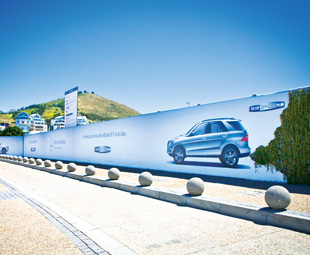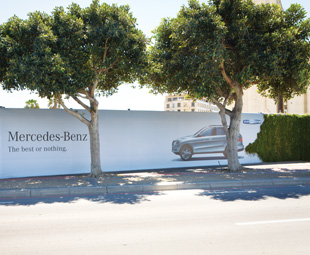Let there be life!

Life is normally the exclusive domain of living entities, right? Not necessarily. South Africa has its very own living wall!
Tourists visiting Cape Town are typically treated to sights such as Table Mountain, Robben Island, wine farms and (apologies in advance for being a party pooper, but I am realistic) the occasional beggar or two at a traffic light.
But they are now being greeted by something quite unexpected – a living wall! The wall itself is unlike any other living thing.
Like some living things – Julius springs to mind – it attracts a lot of attention. Like others (no, Lindsay Lohan this does NOT apply to you), it doesn’t drink much. And, much like Al Gore, it’s doing wonders for the planet.
The wall in question is the so-called “Living Wall green wrap” at the V&A Waterfront. Sponsored by Mercedes-Benz South Africa, it comprises thousands upon thousands of plants – and was borne out of real ingenuity.
The wall was conceived last year. Allan Gray is building what is expected to be a five-star Green Star-rated fully sustainable head office at the V&A Waterfront, and the landlord wanted to do something creative around the building site. It awarded the rights to sell advertising on the site to Big Boom Media, which in turn sold the living wall to Mercedes-Benz.
It’s not the first time Mercedes-Benz has done something as innovative as this, either. “As well as exposing a number of our BlueEFFICIENCY models to passers-by, the previous wrap showcased the Mercedes-Benz C-Class BlueEFFICIENCY model range, and has now been recycled into re-useable bags,” says Claudia Mende, marketing manager of Mercedes-Benz South Africa, further demonstrating the extent of the company’s green consciousness.
BlueEFFICIENCY is Mercedes-Benz’s package of various fuel-economic measures. It encompasses optimisation of weight, aerodynamics, rolling resistance, energy management and the powertrain which together can reduce fuel consumption by up to 30 percent. Needless to say, it is being rolled out across the entire range of Mercedes-Benz vehicles.
The company wants to make petrol engines as efficient as diesel engines, and diesel engines as clean as petrol engines, and so it believes that when it comes to fuel consumption, the latest diesel technology is currently the best option for large sedans and SUVs. It’s for this reason that the company’s popular M-Class range of SUVs is in the limelight this time round.
The new M-Class is fitted with the highly efficient BlueTec exhaust gas treatment system, allowing Mercedes-Benz to achieve its aim for the diesel engine. It is among the world’s cleanest diesel technology.
“As the environmental sustainability of vehicles is gaining importance in our customers’ purchasing decision, we also wanted to advertise our products through an innovative and fresh medium that can also be environmentally compatible,” Mende continues.
So exactly what is the living wall, then? Essentially it is a billboard that combines regular advertising and plants – but this is no ordinary billboard!
Covering over 200 linear metres, and equalling a total of 500 m², it is mounted on construction site hoardings. This is the first time in South Africa that a construction site has hosted a vertical garden of this nature.
It was no mean feat to create the living wall, as Franette Ventura, partner at ACR Group (which “constructed” the wall), explains. “Because this has never been done before, we had to start by researching the concept and establishing whether or not it was actually possible!”
Before going the whole hog, the company assembled a control panel at a nursery in Somerset West. “We replicated the sun conditions and we also wanted to see how the plants would react to dust,” she says. Once the company had established that the wall was indeed viable, the next step was acquiring the thousands upon thousands of plants that would go into the living wall.
The plants were carefully selected based on their ability to withstand severe climate and environmental conditions. Proximity to the ocean, aptitude to sun and shade exposure, as well as the effects of construction, had to be considered. The different species also had to have the same growth characteristics and maintenance requirements. Water-wise, indigenous plants and succulents were selected as far as possible due to their sturdy growth and natural resilience levels.
Availability also played an important role. “There are no nurseries stocking tens of thousands of the same plant!” Ventura comments.
 Then came the actual making of the wall. The living wall comprises a simple layer of irrigation cloth affixed to the hoarding boards. Pockets, cut into the cloth and containing only the minimum required amount of soil, provide a solid footing for plants to establish and grow. The water-conducting irrigation cloth, manufactured from non-degradable deconstructed acrylic textiles, allows for plant roots to firmly spread through the fibres and to absorb water and nutrients. “We had to be ever so careful when we placed each and every plant in the wall,” says Ventura. “We used baby plants – so they had to be treated with tender loving care. It was vitally important that the roots were not damaged.”
Then came the actual making of the wall. The living wall comprises a simple layer of irrigation cloth affixed to the hoarding boards. Pockets, cut into the cloth and containing only the minimum required amount of soil, provide a solid footing for plants to establish and grow. The water-conducting irrigation cloth, manufactured from non-degradable deconstructed acrylic textiles, allows for plant roots to firmly spread through the fibres and to absorb water and nutrients. “We had to be ever so careful when we placed each and every plant in the wall,” says Ventura. “We used baby plants – so they had to be treated with tender loving care. It was vitally important that the roots were not damaged.”
The cloth is irrigated via a simple plastic tube incorporated into the top section of the material, and a diluted nutritive solution is added to the irrigation flow. Watering occurs three to five times daily for one to three minutes, depending on the weather conditions and the stages of plant growth.
According to Ventura, fertilising the plants was a huge challenge. “We tried fertilising them manually with pigeon poo – that was a real mess,” she laughs. “Eventually we came up with a 100 percent organic, water soluble fertiliser that works perfectly.”
Yet another challenge was litter. “I have to be honest,” says Ventura. “We didn’t see that coming. People put all sorts of rubbish in the wall. So we have to delitter it each and every day.”
Then, of course, there is the environment. “We thought the sun would be the biggest challenge, but it’s not,” reveals Ventura. “The wind is a far greater challenge; it dries out the plants.”
A further challenge is theft. “Some visitors to the V&A like our wall so much that they take a piece of it home with them …” Ventura relates with a groan.
But ultimately the project has been an incredible success. These vertical gardens not only enhance the aesthetic qualities of the construction site, but also actively contribute to the improvement of the immediate environment. The leaf surfaces and irrigation cloth trap dust and pollutants emitted by nearby industries, vehicles and the construction process.
“The wall provides good noise suppression, and has attracted birds to what is essentially a construction site. There are lots of birds feeding off our wall; we have even found a bird’s nest in it!” Ventura reveals with excitement.
So the birds are happy. Visitors to the V&A are happy. Mercedes-Benz is happy – “We wanted to create awareness of the substantially reduced fuel consumption and minimal emissions from our latest SUV M-Class range in a manner that is not only kind to the environment, but also reminds us where we stand within nature’s broader realm,” says Mende.
It’s clear that this wall is a real winner.



